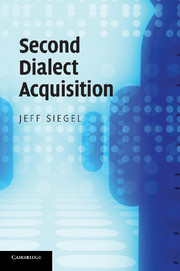Book contents
- Frontmatter
- Contents
- List of figures
- List of tables
- Acknowledgements
- List of abbreviations
- 1 Introduction
- 2 Attainment in naturalistic SDA
- 3 Acquiring a second dialect
- 4 Differential attainment: Age effects and linguistic factors
- 5 Additional individual and linguistic factors
- 6 The difficulty of SDA
- 7 SDA in classroom contexts
- 8 Educational approaches for SDA
- 9 Explaining the results and taking further steps
- Notes
- References
- Index
3 - Acquiring a second dialect
Published online by Cambridge University Press: 07 September 2010
- Frontmatter
- Contents
- List of figures
- List of tables
- Acknowledgements
- List of abbreviations
- 1 Introduction
- 2 Attainment in naturalistic SDA
- 3 Acquiring a second dialect
- 4 Differential attainment: Age effects and linguistic factors
- 5 Additional individual and linguistic factors
- 6 The difficulty of SDA
- 7 SDA in classroom contexts
- 8 Educational approaches for SDA
- 9 Explaining the results and taking further steps
- Notes
- References
- Index
Summary
This chapter looks at some of the phenomena involved in acquiring a new dialect and ways of examining them, based on the studies described inChapter 2 and other research as well. First, I give an explanation for the ways that dialect acquirers are perceived by both D2 and D1 speakers. Then, after talking about imitation, I describe two types of SDA, replacive and additive. In the section that follows I discuss various approaches used to examine SDA.
Perceptions of dialect acquirers
In Chapter 1, I mentioned my own experience of always being recognised as an American in Australia but being told I have a British accent when I'm in America. Shockey (1984: 87) also commented that her American subjects in England “sounded like Americans to British ears and like British people to Americans”. Chambers (1992: 695n) made similar observations:
Dialect acquirers … invariably discover when they revisit their old homes that their dialect is now perceived as “foreign”, yet their neighbors in their new homes also perceive their speech as “non-native”. Immigrants, often to their bafflement, come to sound less like the people in the old region without sounding quite like the people in the new region. The old dialect and the new one are not the converse of one another, but poles on a continuum.
The first part of this chapter explains some of the reasons for this “double foreignness”.
Factors contributing to non-nativeness in the D2
First, let's look at why dialect acquirers continue to be perceived as “non-native”.
- Type
- Chapter
- Information
- Second Dialect Acquisition , pp. 56 - 82Publisher: Cambridge University PressPrint publication year: 2010

